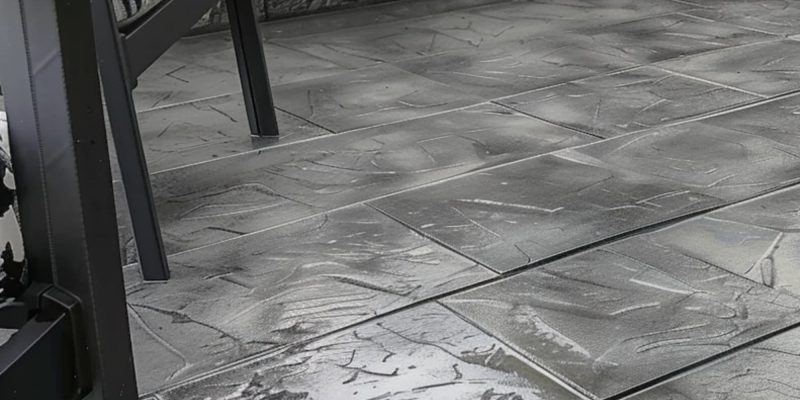Welcome to the world of stamped concrete—a smart choice for those looking to upgrade their outdoor spaces without breaking the bank. If you’re considering a fresh look for your patio, driveway, or walkways, stamped concrete offers the durability and aesthetic appeal you’re seeking at a fraction of the cost of natural materials. Let’s dive into what makes stamped concrete the go-to option for homeowners aiming for both style and substance.
What Is Stamped Concrete?
At its core, stamped concrete is a clever way to make your concrete look like something else—be it brick, stone, or even wood. By pressing molds into the concrete before it fully sets, professionals can create patterns and textures that mimic more expensive materials. This technique not only adds a unique flair to your outdoor areas but also brings a level of customization that’s hard to beat.
The Process of Creating Stamped Concrete
The journey to a stunning stamped concrete surface begins with the preparation of the base, which is crucial for a smooth installation process. Next, concrete is poured over the area, and while it’s still wet, large stamps are pressed down to create the desired patterns.
While concrete is still wet, large stamps are pressed down…
After the concrete dries, a sealant is applied to protect the surface and enhance the color. This multi-step process ensures your stamped concrete not only looks fantastic but lasts for years to come.
Advantages and Disadvantages
Advantages
- Durability: Stamped concrete stands up to the test of time, resisting wear from weather, traffic, and heavy use.
- Low-Maintenance: Unlike natural stone or brick, stamped concrete requires minimal upkeep to keep it looking great.
- Versatility: With a wide range of patterns and colors available, stamped concrete can be tailored to match any home’s style.
- Cost-Effective: Achieve the look of high-end materials at a fraction of the cost, making it a budget-friendly choice for big and small projects alike.
Disadvantages
- Cracking: While durable, stamped concrete can crack over time, especially if the base preparation and installation were not done correctly.
- Color Fading: Exposure to sunlight and weather can cause the colors to fade, necessitating occasional resealing to maintain its vibrant look.
- Slippery When Wet: Some stamped concrete finishes can be slippery when wet, although adding a non-slip additive to the sealant can mitigate this issue.
Uses of Stamped Concrete
Stamped concrete’s versatility makes it an ideal choice for various applications around the house:
- Patios and Outdoor Living Areas: Transform your backyard into a stylish retreat for family gatherings or quiet evenings outdoors.
- Driveways and Walkways: Boost your home’s curb appeal with a durable, attractive driveway or welcoming walkway.
- Pool Decks: Create a safe and beautiful poolside area with stamped concrete designed to complement your home’s exterior.
Stamping Concrete vs. Other Concrete Finishes
Comparative Analysis with Plain Concrete
Plain concrete, while practical and straightforward, lacks the visual appeal and texture that stamped concrete offers. Stamped concrete elevates the aesthetic dimension, allowing homeowners to mimic more expensive materials like natural stone, slate, or even wood, giving their outdoor spaces a customized, high-end look without the high-end price tag.
Comparison with Other Decorative Concrete Finishes
Compared to other decorative concrete finishes such as stained or polished concrete, stamped concrete stands out for its three-dimensional texture and pattern variety. While stained concrete offers color variation and polished concrete provides a sleek finish, stamped concrete delivers both color and texture, making it an all-in-one solution for homeowners seeking depth and character in their outdoor surfaces.
Patterns, Color, and Texture Options
Variety of Patterns
From the natural elegance of stone and slate to the rustic charm of wood planks, stamped concrete offers an array of patterns to suit any preference. These patterns are created using molds that imprint concrete with designs that closely resemble the real materials, offering endless possibilities to match any architectural style or landscape design.
Color Options
The color in stamped concrete is achieved through two methods: adding color directly to the concrete mix or applying a color hardener to the surface before stamping. This allows for a broad spectrum of colors, from earth tones that blend seamlessly with natural surroundings to bold hues that make a statement.
Texture and Finish Choices
The final texture and finish of stamped concrete can range from smooth and polished to rough and natural. This is determined by the type of stamp used and the additional texturing tools applied during the stamping process.
NOTE
The choice of finish affects the appearance and functionality of concrete, with rougher textures providing better slip resistance.
Maintenance Tips
Maintaining stamped concrete is straightforward, ensuring it stays beautiful for years to come:
- Regular Cleaning and Care: Sweep regularly and wash with a hose to remove dirt and debris. For tougher stains, a mild detergent and a brush can be used.
- Resealing Procedures: Applying a sealant every 2-3 years will protect the color and surface of your stamped concrete from wear and tear, including fading and water damage.
- Winter Care Tips: In colder climates, avoid using deicing chemicals that can damage the surface. Instead, use sand for traction in icy areas.
Common Issues and FAQs
Why Does My Stamped Concrete Crack?
Cracks can occur if the base isn’t properly prepared or if the concrete isn’t mixed correctly. Small, hairline cracks are normal and can be filled with a matching color hardener to minimize their appearance.
How Can I Restore Faded Color on My Stamped Concrete?
Faded color can be revitalized with a new coat of sealant or, in some cases, re-coloring the concrete. Consult a professional to choose the best approach for your specific situation.
Is Stamped Concrete Slippery?
Stamped concrete can be slippery when wet, especially if sealed with a high-gloss sealant. However, adding a non-slip additive to the sealant or choosing a texture with more grip can prevent slip hazards.
How Much Does Stamped Concrete Cost?
The cost of stamped concrete varies depending on the complexity of the design and the size of the area. Generally, it’s more affordable than natural stone or pavers, offering a cost-effective way to achieve a high-end look.
Conclusion
Stamped concrete is a versatile, durable, and cost-effective solution for enhancing outdoor living spaces. With a wide range of patterns, colors, and textures, it allows homeowners to create unique and beautiful environments tailored to their style and needs. By following simple maintenance tips, your stamped concrete can remain a stunning feature of your home for years to come. Whether you’re updating your patio, driveway, or pool deck, stamped concrete offers the perfect blend of functionality and aesthetic appeal.

